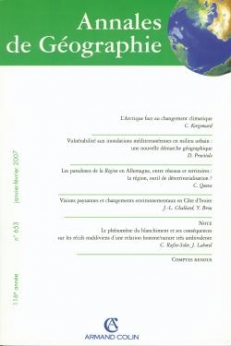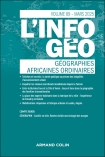
Annales de Géographie n° 653 (1/2007)
Pour acheter ce numéro, contactez-nous
Recevez les numéros de l'année en cours et accédez à l'intégralité des articles en ligne.
Depuis la fin des années 1990, la région est devenue, en Allemagne, un outil central d’aménagement « par le bas » et de développement (Raumentwicklung), par opposition à la traditionnelle planification spatiale ( Raumplanung). Mais la Region reste une entité ambiguë, entre territoires et réseaux, structures formelles et informelles. Il s’agit en fait de distinguer deux types de régions : la région d’aménagement ou de planification, et la région au sens large. Les deux premières correspondent à un même espace de planification exogène, considéré soit du point de vue du Bund (Raumordnungsregion), soit de celui des Länder (Planungsregion). La région au sens large (Region) désigne, quant à elle, un espace d’action local fondé sur des coopérations souvent réticulaires et informelles. Or, ce sont les relations entre ces deux entités qui font, en Allemagne, le développement régional ( Regionalentwicklung) – on parlerait en français de « développement local ». Il se dessine ainsi une dynamique paradoxale, dans laquelle domine dans un premier temps le rejet de toute rigidité territoriale, par le choix du flou dans des coopérations thématiques et réticulaires. Par la suite, se manifeste la nécessité d’un retour au territoire, plus ou moins assumé et revendiqué par les acteurs locaux. Des exemples nationaux et régionaux (région d’aménagement de Thuringe du Sud Ouest) viennent illustrer cette réflexion.
From the end of the 1990s onwards, German spatial planning experiences have been enhancing the value of the notion of Region as a key tool in “bottom-up spatial planning” ; thus moving on from Raumplanung (spatial planning) to Raumentwicklung (spatial development). However, the region remains ambivalent, prevailing. But on the other hand, the need to go back to the notion of territory is still felt, if not always accepted, by local actors. The region would first be used as a deterritorializating device at the stage of regional development projects, before being turned into a reterritorializating tool afterwards, when implementing actions and projects. I will use a few national (German) and regional examples (the spatial planning region of South-West Thuringe) to illustrate these ideas. standing as it is between territories and networks, formal and informal structures. There are two identifiable types of regions in Germany : the region as defined by spatial planning and the region in general. The first one (Raumordnungsregion when applied to the Bund, and Planungsregion when applied to the Länder) is an external planning instrument, thus coordinating local actors and their projects. This is grounded upon the territorial divisions within each Land. Regions in general (Region) are spaces intended for local action, founded upon reticular patterns of cooperation rather than upon territorial ones, such as urban networks, regional development concepts, etc. But local/regional development rests upon these two interweaving/interacting entities. The play on scales and the ambivalent relations between networks and territories in regional development are at the core of this article. Eventually, this leads us to a paradoxical form of dynamism. On the one hand, the dismissal of territorial rigidity and the choice of weak, thematic and reticular cooperation seem to be prevailing. But on the other hand, the need to go back to the notion of territory is still felt, if not always accepted, by local actors. The region would first be used as a deterritorializating device at the stage of regional development projects, before being turned into a reterritorializating tool afterwards, when implementing actions and projects. I will use a few national (German) and regional examples (the spatial planning region of South-West Thuringe) to illustrate these ideas.

